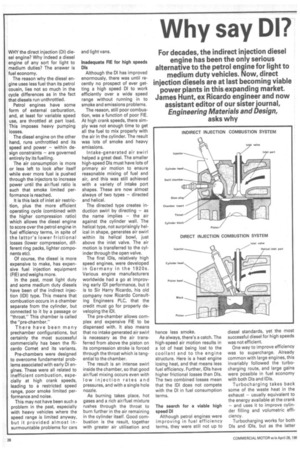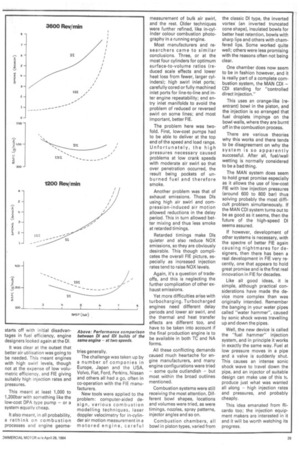Why say DI?
Page 30

Page 31

If you've noticed an error in this article please click here to report it so we can fix it.
For decades, the indirect injection diesel engine has been the only serious alternative to the petrol engine for light to medium duty vehicles. Now, direct injection diesels are at last becoming viable power plants in this expanding market. James Hunt, ex Ricardo engineer and now assistant editor of our sister journal Engineering Materials and Design, asks why
WHY the direct injection (DI) diesel engine? Why indeed a diesel engine of any sort for light to medium duties? The answer is fuel economy.
The reason why the diesel engine uses less fuel than its petrol cousin, lies not so much in the cycle differences as in the fact that diesels run unthrottled.
Petrol engines have some form of external carburation, and, at least for variable speed use, are throttled at part load. This imposes heavy pumping losses.
The diesel engine on the other hand, runs unthrottled and its speed and power — within design constraints — are governed entirely by its fuelling.
The air consumption is more or less left to look after itself while ever more fuel is pushed through the injectors to increase power until the air/fuel ratio is such that smoke limited performance is reached.
It is this lack of inlet air restriction, plus the more efficient operating cycle (combined with the higher compression ratio) which allows the diesel engine to score over the petrol engine in fuel efficiency terms, in spite of the latter's lower frictional losses (lower compression, different ring packs, lighter components etc).
Of course, the diesel is more expensive to make, has expensive fuel injection equipment (FIE) and weighs more.
In the past, most light duty and some medium duty diesels have been of the indirect injection (IDI) type. This means that combustion occurs in a chamber separate from the cylinder, but connected to it by a passage or "throat." This chamber is called the "pre-chamber."
There have been many prechamber configurations, but certainly the most successful commercially has been the Ricardo Comet and its variants.
Pre-chambers were designed to overcome fundamental problems associated with early DI engines. These were all related to inefficient combustion, especially at high crank speeds, leading to a restricted speed range, poor smoke limited performance and noise.
This may not have been such a problem in the past, especially with heavy vehicles where the speed range is limited anyway, but it provided almost insurmountable problems for cars and light vans.
Inadequate FIE for high speeds Dls Although the DI has improved enormously, there was until recently no prospect of ever getting a high speed DI to work efficiently over a wide speed range without running in to smoke and emissions problems.
The reason, still poor combustion, was a function of poor FIE. At high crank speeds, there simply was not enough time to get all the fuel to mix properly with the air in the cylinder. The result was lots of smoke and heavy emissions.
Intake-generated air swirl helped a great deal. The smaller high-speed Dls must have lots of primary air motion to ensure reasonable mixing of fuel and air, and this was still achieved with a variety of intake port shapes. These are now almost always of two types — directed and helical.
The directed type creates induction swirl by directing — as the name implies — the air against the cylinder wall. The helical type, not surprisingly helical in shape, generates air swirl within its helical bowl, just above the inlet valve. The air motion is transferred to the cylinder through the open valve.
The first IDIs, relatively high speed engines, were developed in Germany in the 1920s. Various engine manufacturers worldwide had a go at improving early IDI performance, but it is to Sir Harry Ricardo, his old company now Ricardo Consulting Engineers PLC, that the credit must go for properly developing the IDI.
The pre-chamber allows complex and expensive FIE to be dispensed with. It also means that no intake generated air swirl is necessary as the air transferred from above the piston on its compression stroke is forced through the throat which is tangential to the chamber.
The result is an intense swirl inside the chamber, so that good air/fuel mixing occurs even with low injection rates and pressures, and with a single hole nozzle.
As burning takes place, hot gases and a rich air/fuel mixture rushes through the throat to burn further in the air remaining in the cylinder itself. Good combustion is the result, together with greater air utilisation and hence less smoke.
As always, there's a catch. The high-speed air motion results in a lot of heat being lost to the coollant and to the engine structure. Here is a heat engine losing heat, and that means less fuel efficiency. Further, IDIs have higher frictional losses than DIs. The two combined losses mean that the IDI does not compete with the DI in fuel consumption terms.
The search for a viable high speed DI Although petrol engines were improving in fuel efficiency terms, they were still not up to diesel standards, yet the most successful diesel for high speeds was not efficient.
One way to improve efficiency was to supercharge. Already common with large engines, this invariably followed the turbocharging route, and large gains were possible in fuel economy with both Dls and IDIs.
Turbocharging takes back some of the waste heat in the exhaust — usually equivalent to the energy available at the crank — and uses it to improve cylinder filling and volumetric efficiency.
Turbocharging works for both Dls and IDIs, but as the latter starts off with initial disadvantages in fuel efficiency, engine designers looked again at the DI.
It was clear at the outset that better air utilisation was going to be needed. This meant engines with high swirl levels, though not at the expense of low volumetric efficiency, and FIE giving suitably high injection rates and pressures.
This meant at least 1,000 to 1,200bar with something like the low-cost DPA type pump — or a system equally cheap.
It also meant, in all probability, a rethink on combustion processes and engine geome tries generally.
The challenge was taken up by a number of companies in Europe, Japan and the USA. Volvo, Fiat, Ford, Perkins, Nissan and others all had a go, often in co-operation with the FIE manufacturers.
New tools were applied to the problem: computer-aided design, various combustion modelling techniques, laser doppler velocimetry for in-cylinder air motion measurement in a motored engine, careful measurement of bulk air swirl, and the rest. Older techniques were further refined, like in-cylinder colour combustion photography in a running engine.
Most manufacturers and resea rchers came to similar conclusions. Three, or at the most four cylinders for optimum surface-to-volume ratios (reduced scale effects and lower heat toss from fewer, larger cylinders); high swirl inlet ports; carefully cored or fully machined inlet ports for line-to-line and inter engine repeatability; end entry inlet manifolds to avoid the problem of reduced or reversed swirl on some lines; and most important, better FIE.
The problem here was twofold. First, low-cost pumps had to be able to deliver at the top end of the speed and load range. Unfortunately, the high pressures necessary caused problems at low crank speeds with moderate air swirl so that over penetration occurred, the result being pockets of unburned fuel and therefore smoke.
Another problem was that of exhaust emissions. Those Dls using high air swirl and compression-induced air motion allowed reductions in the delay period. This in turn allowed better mixing and thus less smoke at retarded timings.
Retarded timings make Dls quieter and also reduce NOX emissions, so they are obviously desirable. This though complicates the overall FIE picture, especially as increased injection rates tend to raise NOX levels.
Again, it's a question of tradeoffs, and this is neglecting the further complication of other exhaust emissions.
Yet more difficulties arise with turbocharging. Turbocharged engines need different delay periods and lower air swirl, and the thermal and heat transfer effects are different too, and have to be taken into account if the final production engine is to be available in both TC and NA forms.
All these conflicting demands caused much heartache for engine manufacturers, and many engine configurations were tried — some quite outlandish — but most within the broad outlines mentioned.
Combustion systems were still receiving the most attention. Different bowl shapes, locations and volumes were tried, as were timings, nozzles, spray patterns, injector angles and so on.
Combustion chambers, all bowl in piston types, varied from the classic DI type, the inverted vortex (an inverted truncated cone shape), insulated bowls for better heat retention, bowls with sharp lips and others with chamfered lips. Some worked quite well; others were less promising with the reasons often not being clear.
One chamber does now seem to be in fashion however, and it is really part of a complete combustion system, the MAN CDI — CDI standing for "controlled direct injection."
This uses an orange-like (reentrant) bowl in the piston, and the injection is so arranged that fuel droplets impinge on the bowl walls, where they are burnt off in the combustion process.
There are various theories why this works and there tends to be disagreement on why the system is so apparently successful. After all, fuel/wall wetting is normally considered to be a bad thing.
The MAN system does seem to hold great promise especially as it allows the use of low-cost FIE with low injection pressures (around 600 to 800 bar) thus solving probably the most difficult problem simultaneously. If the MAN CDI system turns out to be as good as it seems, then the future of the high-speed DI seems assured.
If however, development of other systems is necessary, with the spectre of better FIE again causing nightmares for designers, then there has been a real development in FIE very recently, one that appears to hold great promise and is the first real innovation in FIE for decades.
Like all good ideas, it is simple, although practical considerations have made the device more complex than was originally intended. Remember the banging in your water pipes called "water hammer", caused by sonic shock waves travelling up and down the pipes.
Well, the new device is called the "fuel hammer" injection system, and in principle it works in exactly the same way. Fuel at low pressure moves in a pipe and a valve is suddenly shut. This causes an intense sonic shock wave to travel down the pipe, and an injector of suitable design can make use of this U.. produce just what was wanted all along — high injection rates and pressures, and probably cheaply.
This idea emanated from Ricardo too; the injection equipment makers are interested in it and it will be worth watching its progress.




































































































